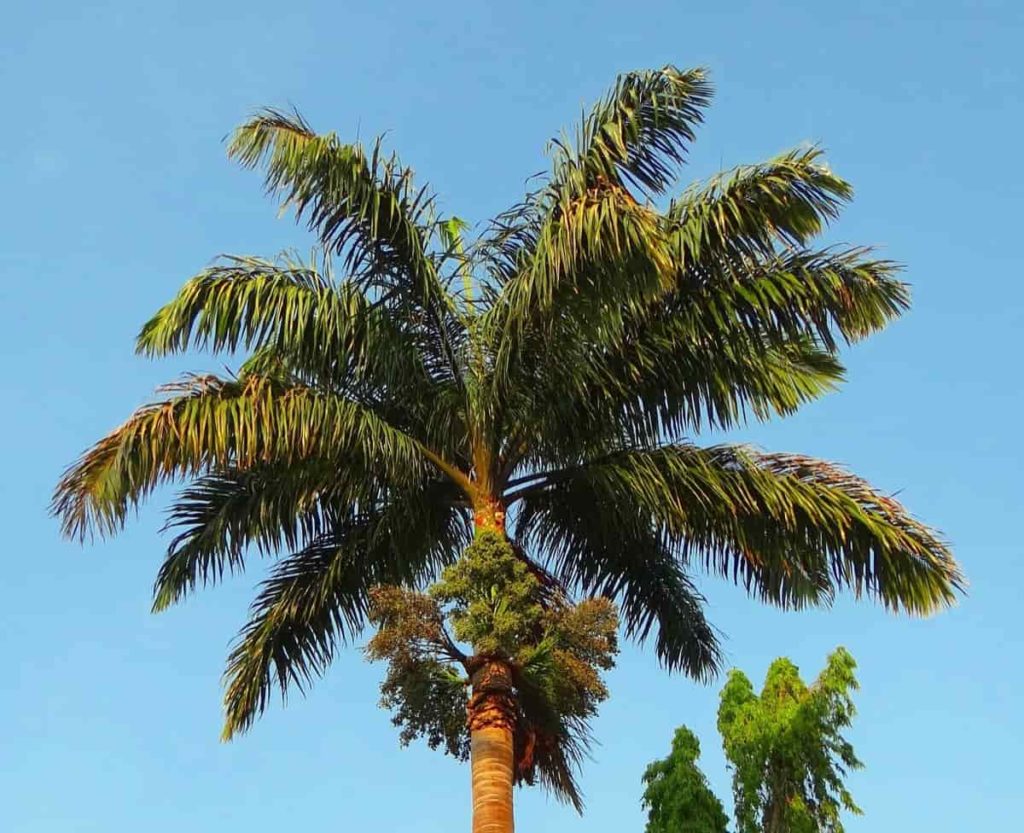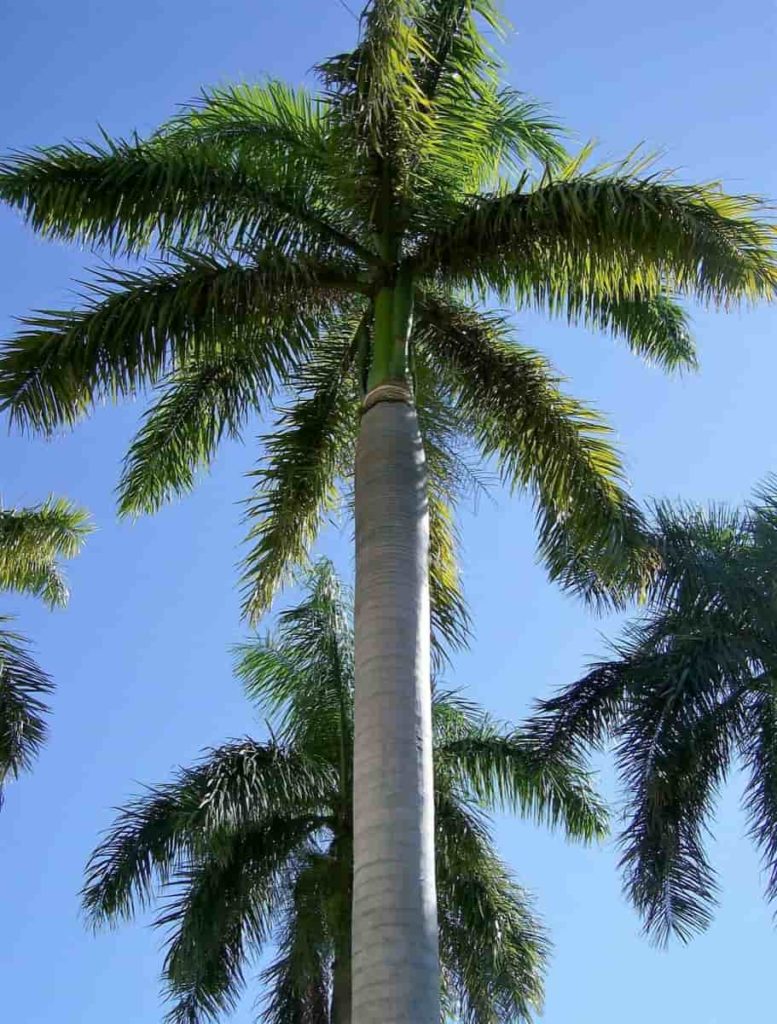Palm plants can be unique and magnificent interior plants, in addition to their duty as aesthetic trees in warmer areas. Mature palms are frequently used to decorate public rooms and foyers, lending the design an attractive and decidedly tropical feel. Simultaneously, very little, immature palms can be employed as a splash of greenery in the home. Let’s check out a detailed guide to growing Palm trees.

It’s easy to think of palm trees as strictly tropical plants that will thrive with lots of sunlight and water. There are, however, desert species that will drown if given too much water, and others that would not survive without fertilizer. To grow a palm effectively, you must conduct extensive studies on the specific species you choose. Often these palms can be grown in the early spring and will grow slowly, gaining less than 10 inches of height per year on average.
Guide to growing Palm trees
Choosing Palm trees as per your need
Palms are a huge, diversified collection of plants that may be found in a variety of environments, from deserts to rainforests. Pay special attention to plant tags or nursery catalog descriptions while selecting palms, and keep these two factors in mind:
Winter hardiness
Hardiness isn’t a huge worry for palms that spend the winter securely indoors. However, when it comes to landscaping palms, it’s crucial to match the tree to your climate. Some cold-hardy palms can endure snow and temperatures well below zero degrees Fahrenheit, but others will succumb to frost.
Mature size
Indoors or out, always account for the tree’s future height and spread. Because containers limit the size of plants, even naturally huge palms may be kept manageable in pots. When planted in the ground, however, the identical plants can grow to be several times their indoor size.
Those who reside in frost-free areas of the country have access to an almost limitless supply of palm tree species that will thrive when planted outside. If your environment is more moderate, don’t worry; there are many cold-hardy palm palms to choose from. Furthermore, there are a variety of hardy palm varieties that can be grown in pots both indoors and outdoors, so there is a palm to suit everyone’s needs and wants.
In case you miss this: Cinnamon Tree Planting, Tips, Ideas, And Techniques
Before you go out and buy a new palm, do some research to make sure it will grow well in your planned circumstances. Many palms thrive in USDA zones 8 through 10, with a few tolerating the warmer zones of zone 7. Knowing what USDA zone you reside in can assist you to to choose a palm that will thrive in your area. You can also learn if the palm you choose is hardy in pots or better suited for planting in the landscape.
What are the types of indoor and outdoor palm trees?
There’s a palm to tickle your fancy, whether you’re seeking airy fronds, sturdier-appearing fan-shaped kinds, cold-hardy palms, or ones appropriate for pots. The following are some of the more common palms, along with their hardiness zones and characteristics:
- Windmill palm: Sturdy in USDA zones 8-11, cold-hardy, slow-growing, good home plant or potted palm, fan-shaped, green fronds, and a trunk that resembles burlap.
- Queen palm: Sturdy in USDA zones 9-11, with green feather-like fronds and modest growth.
- Coconut palm: Coconut palms are resilient in USDA zones 10-11, with green to greenish-yellow fronds that are featherlike.
- Parlour palm: Resilient in USDA zones 9-10, appropriate as a houseplant or potted palm, grows slowly and has green pinnate fronds.
- Chinese fan palm: Resilient in USDA zones 8-10, Chinese fan palm is a good houseplant or potted palm with olive green palmate leaves that develop slowly.
- Pygmy date palms: Pygmy date palms are hardy in USDA zones 9-11, make good container plants, and have glossy green pinnate and prickly fronds that grow slowly.
- Needle palm: USDA zones 7–10, cold-hardy, slow-growing with green pinnate fronds and a clumping habit.
- Sable palm: Sable or cabbage palms are hardy in USDA zones 8-10, cold-hardy, and have green, fan-shaped fronds.
How to grow palm trees at home?
Site selection for growing palm trees
Following your selection of the ideal palm tree, the next critical step incorrectly planting the palm tree is to choose a suitable location in the landscape that fits all of the tree’s growth needs. By examining the plant tag or studying the features and growth needs of a certain palm, you may learn essential facts about the tree that will help you choose the ideal location in the landscape for planting.
In case you miss this: How to Grow Rudraksha Tree at Home

The following is crucial information: Optimal lighting conditions, mature height, and breadth, producing single trunk or numerous trunks, fronds that be thorny or smooth. When planting a new palm tree in its permanent location, it’s crucial to place it in the right light circumstances, since the palm’s development is stunted if it doesn’t get the light it needs. You don’t want to put a palm that needs full sun in a spot that only gets shade, and you don’t want to put a palm that thrives in shady spots in full light.
Furthermore, understanding the palm’s predicted size aids in selecting a location where the tree will not interfere with structures or electricity lines. Planting palm trees near a home or pool is OK, but you should evaluate their mature height and breadth to ensure that they don’t encroach on a roof or overrun a screened pool enclosure, causing unnecessary damage or expenditure.
Choose a location that is spacious enough for the palm to reach its full potential while also being free of interference or injury. Allowing the palm to extend to its maximum width without the need to prune fronds is the best option. Pruning off foliage that isn’t entirely brown and dead isn’t good for the tree.
Palm trees can develop single trunk trees or clump together, forming numerous trunks over time, depending on the species. Furthermore, some varieties have smooth fronds while others have thorny lines. Planting palm palms with spiky fronds in regions where there is traffic or children is usually not a good idea.
Soil preparation of palm trees for pots and outdoors
Palms adapt to a broad range of soils as a group, as long as the soil drains effectively. Palms have shallow roots that require a lot of air; they won’t grow in waterlogged soil. Choose a fast-draining, moisture-retentive potting mix suited for container cultivation for potted palms. Choose a large ornamental container with drainage holes that is weighty enough to balance out the size of your hand and will not simply topple over.
The very same slightly acidic, well-draining soil that lawn grasses enjoy is ideal for landscape palms. A soil test can determine if your outside palm might benefit from soil amendments to improve nutrient availability and regulate the pH of the soil.
How to grow palm trees from seeds?
Air layering, cuts, and division are ineffective for reproducing new palm plants in most cases. The easiest approach to begin growing a palm tree is from seed, which may be bought from a seed catalog or a blossoming tree. The first step is to sprout the seed, which you may accomplish by planting it in a container with a thin layer of dirt at least 4 inches thick.
Place the container in a warm, humid spot while you wait for it to sprout—the seed can take two months or more to grow depending on the variety. Once the seed is germinated, place the palm in a bright area and continue to allow it to develop. A few months into the palm’s development phase, feed it a mild liquid fertilizer. You can transfer the palm into a larger pot once it has grown several sets of leaves.
In case you miss this: Growing Indoor Palm plants – A Full Guide

How to plant palm trees outdoors?
Plant palm trees in the spring, after the fear of freezing weather, has gone, in colder climates. Planting palm plants during dry seasons is a bad idea since immature palms are more vulnerable to weather fluctuations. When it’s time to plant your palm, dig a hole that’s at least twice as large as the root ball’s size and no deeper than the root ball. When touching your new palm tree, take care, especially when it comes to the heart.
The heart is the sensitive section of the palm from which the leaves develop, and if it cracks or breaks, your palm’s growth will be hindered, and it may even die. When removing the root ball from the container, use caution. To avoid root injury, it may be better to cut the container off from the palm. When the palm is out of the container, level the hole so that the bottom of the palm’s trunk is flat with the garden’s soil level. Then, to aid root development, refill it with loose soil.
Light requirements for palm trees
When it comes to light, palms may be fussy. It’s crucial to understand your palm’s preferences. Planting a palm tree in the shadow if it likes the light will result in a weak plant with a strong trunk and palm tree leaves extended out toward the sun. If you put a palm that prefers shade in bright sunshine, the leaves will dry and become brown till they die.
How and when to water your palm trees?
For the flourishing of palm plants, proper drainage is critical. Palms do not like to get wet just though they reside in warm climates. Many palms thrive in somewhat sandy soils with good drainage. Allow the soil to dry out between waterings and never let the root ball of a palm remain in the water. You may also put your palm in a terracotta or clay jar to assist it wick extra moisture from the soil.
Keep your palm thoroughly hydrated for 2 to 3 weeks once you’ve planted it. A soaker hose wrapped around the root region can keep it wet while conserving water. After your palm has established itself, you may reduce soak-watering to roughly 15 minutes twice per month. During the winter, reduce the amount of water you use.
Fertilizer requirements for palm trees
During the growth season, feed your palm regularly. Choose a palm fertilizer that contains all of the necessary elements for a healthy palm, as well as additional potassium and manganese, if feasible. Potassium shortage in palms is particularly frequent, resulting in fading or brownish fronds. It’s time to increase your feedings if you observe your palm twisting.
In case you miss this: Trellising and Staking Benefits for Plants in Your Garden

Temperature required for the proper growth of palm trees
Palms grow in a variety of climatic zones. Certain species are native to hot climates all year. Daytime highs reach 95 degrees Fahrenheit, while nighttime lows seldom fall below 78 degrees Fahrenheit. Palms may have daytime highs in the 70s or 80s and nighttime lows in the 40s or 50s in hilly areas. Some species can see snow on occasion, while others must endure temperatures of above 100 degrees Fahrenheit.
It’s all about understanding how much your hand can take, especially at night. Some people can withstand a broad variety of temperatures, whereas others cannot. The temperatures in your region throughout the year can assist you to select which palm species will thrive best for you.
Pruning of palm trees
It’s difficult to resist the urge to trim fronds, yet many palm species receive nutrients from old fronds even after they’ve begun to yellow or brown. Over-pruning palm palms is a typical error that can weaken the plant and deprive it of essential nutrients. In general, never remove browned leaves from your palm, and never chop it down to only one or two fresh fronds.
Pests and diseases that occur to palm trees
Several forms of fungus attack palms, including fusarium wilt and diamond scale. Some fungi induce decay at the tree’s top or towards the base. A commercial fungicide may be able to help. If the ground level of your tree has deteriorated, scrape some of the soil aside from the trunk and ensure you’re not overwatering it.
The enormous palm borer, a beetle that burrows into the trunk, and scale, an insect that appears like little bumps on the tree’s surface, are two pests that prey on different species of palm trees. Your tree may potentially be infested by mites and caterpillars. If you’re not sure what pest is attacking your palm, horticultural oil or pesticide may help, but it’s best to visit an arborist.
- Flower Garden Designs and Layouts for Beginners
- Planting and Spacing Techniques in Papaya: A Beginner’s Guide
- Growing Gold: Essential Techniques for Planting Pineapples
- How to Make Kalanchoe Plant Bushy: Home Remedies and Solutions
- 11 Reasons Why Your Gardenia is Not Blooming: Home Remedies and Solutions
- Eco Elegance: The Guide to Designing a Drought-Tolerant Landscape
- Gardening on a Slope: Strategies for Hillside Landscaping
- Nourish and Flourish: Top Organic Mulches for Thriving House Plants
- Everything You Want to Know about Indian Mogra Flower: Discover Uses and Growing
- Green Thumb Success: Expert Tips for Cultivating Greenhouse Pumpkins All Year Round
- Maximize Growth & Flavor: The Ultimate Guide to Companion Planting in Herb Gardens
- How to Control Rhododendron Problems Naturally: Home Remedies and Organic Ways to Fix Them
- Natural Magic: The Remarkable Benefits of Cinnamon for Plants
- Best Steps to Revive Dying Tulip with Natural and Organic Treatment
- 10 Reasons Why Your Angel Trumpet is Not Blooming: Remedies and Treatment
- How to Fix Periwinkle Leaf and Flower-Related Problems: Natural Remedies and Solutions
- How to Fix Zinnias Leaf and Flower Problems: Discover Natural and Home Remedies
- Organic Steps to Induce Lemon Tree Flowers: A Comprehensive Guide
- Bloom Booster: Crafting the Perfect Homemade Bougainvillea Fertilizer
- Optimizing Growth: A Guide to Applying NPK Fertilizer for Potted Plants
- 10 Best Homemade Fertilizers for Rubber Plant: DIY Recipes and Application Method
- How to Boost Female Pumpkin Flowers: Effective Steps for More Flowers and High Yields
- Transform Your Indoor Garden: Top Benefits of Pink Salt for Houseplants
- 10 Best Homemade Fertilizers for Peacock Plants (Calathea): Easy DIY Guide
- Unlock Blooms: 9 Reasons Why Your Potted Chrysanthemum is Not Blooming
- 8 Reasons Why Your Potted Hibiscus is Not Blooming: Fix it with Simple Solutions
- Unlock Blooms: 9 Key Reasons Your Potted Frangipani Won’t Flower
- 10 Reasons Why Is My Ice Plant Not Blooming: Remedies and Treatment
- 10 Reasons Why My Potted Hydrangea Not Blooming: Treatment and Remedies
- 10 Reasons Why is My Wisteria Not Blooming: Remedies and Treatment
- 10 Reasons Why is My Goldfish Plant Not Blooming: Remedies and Treatment
- Maximize Your Space: Ultimate Guide to Balcony Gardening with Grow Bags
- 10 Reasons Why Your Iris is Not Blooming: Remedies and Treatment
- 10 Reasons Why Your Anthurium Plant is Not Blooming: Treatment and Remedies
- 10 Reasons Why Your Aquaponic Plants Are Not Flowering: Remedies and Treatment
- 10 Reasons Why Your Agapanthus is Not Flowering: Remedies and Treatment
